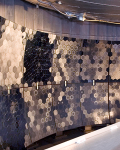Because of their unique properties, ionic liquids could have substantial scientific and commercial importance. Energy-related applications include electrolytes not only in fuel cells but also in batteries and supercapacitors, which rapidly extract current from batteries to operate electric motors.
Sheng Dai, a researcher in ORNL’s Chemical Sciences Division, has synthesized a novel ionic liquid form that shows promise as an electrolyte in proton-conducting fuel cells. In collaboration with Eugene Mamontov, chief instrument scientist at the SNS Backscattering Spectrometer, BASIS, and other researchers, he used quasielastic neutron scattering (QENS) to study the diffusion properties of this new liquid.
“A unique property of any ionic liquid is that it does not evaporate because it has no vapor pressure,” says Dai. “By contrast, water has a vapor pressure. Thus wet clothes hanging outside in sunlight will dry because water readily evaporates into the warm air.” Other useful features of room-temperature ionic liquids, adds Dai, are high conductivity and a large gap between the melting and decomposition temperatures.
When sodium chloride—table salt in solid form—is heated until it melts, the molten salt becomes an ionic liquid, a salt that forms a stable liquid at the salt’s melting temperature. It consists of an array of positively charged ions (cations) and negatively charged ions (anions) that move around in the liquid in a process called diffusion.
The new ionic liquid consists of perfluorinated anions and guanidinium cations. The former contain carbon, fluorine, nitrogen, oxygen, and sulfur. The latter are formed by the addition of a proton to each guanidine nucleus, creating a positively charged ion with the chemical power to combine with an anion.
Guanidine is a strongly alkaline crystalline compound containing nitrogen, hydrogen, and carbon [NHC(NH2)2] that is formed by the oxidation of guanine. It is found in urine as a product of protein metabolism. Guanine is a purine base (C5H5ON5) that is an essential constituent of both RNA and DNA.
“Basically what we did was to neutralize strong organic bases using superacids,” Dai says.
Dai wanted to analyze diffusion processes in the synthesized salt as both a solid and an ionic liquid. Because neutrons are strongly scattered by hydrogen nuclei, Mamontov and scientist Huimin Luo, also of ORNL, were able to use QENS to distinguish among types of cation diffusion in the liquid.“We investigated the dynamics of the ORNL-made salt and ionic liquid in detail,” Mamontov says. “By using the power of neutron scattering, such as sensitivity to both the time and spatial scale of atomic motions, we got results that cannot be obtained using other techniques, such as nuclear magnetic resonance spectroscopy.”
By adjusting the temperature of the salt, the scientists could study differences in “diffusion jumps” in the novel ionic liquid.
Using QENS, Mamontov’s team identified two types of diffusion of cations—long-range translational diffusion and localized diffusion. The faster localized diffusion process is very unusual, but the same ORNL team has confirmed its presence in another novel class of silver complex-based ionic liquids.
“There is a strong possibility that the fast localized diffusion may be common across a wide range of ionic liquids. These two processes, long-range and localized diffusion, occur only in the liquid phase,” Mamontov says.
“We can trace the movements of the cations using neutron scattering because they have lots of hydrogen ions,” Mamontov adds. “We call the technique ‘quasielastic neutron scattering’ because the neutrons gain or lose a tiny amount of energy when they collide with protons in rapidly moving cations in the ORNL ionic liquid.”
Mamontov, Luo, and Dai concluded that the long-range proton transfer needed for fuel cell electrolytes might be associated with the unrestricted diffusion process in the ORNL ionic liquid. The liquid was recently demonstrated to be a highly efficient electrolyte for fuel cells by the research group of Professor Snyder at Johns Hopkins University (see Nat. Mater. 9, 904 (2010).
This research was funded by the U.S. Department of Energy (DOE) Office of Basic Energy Sciences.
Published Work
E. Mamontov, G. A. Baker, H. Luo, and S. Dai, “Microscopic diffusion dynamics of silver complex-based room temperature ionic liquids probed by quasielastic neutron scattering,” ChemPhysChem 12, 944 (2011).
E. Mamontov, H. Luo, and S. Dai, “Proton dynamics in N, N, N#, N#-tetramethylguanidinium bis(perfluoroethylsulfonyl)imide protic ionic liquid probed by quasielastic neutron scattering,” J. Phys. Chem. B 113(1), 159 (2009).






